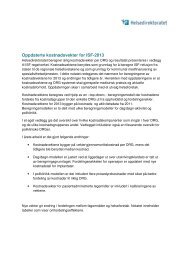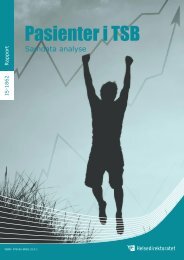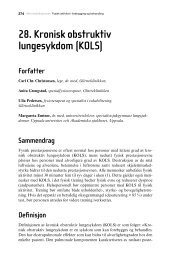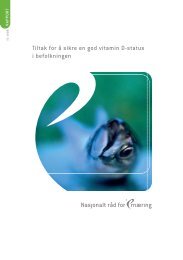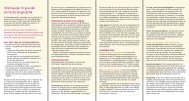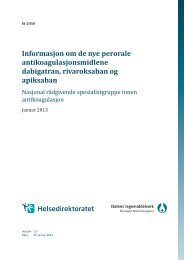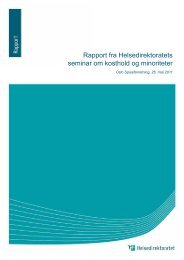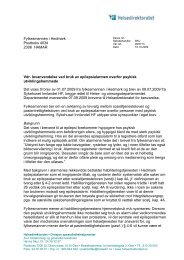Last ned - Helsedirektoratet
Last ned - Helsedirektoratet
Last ned - Helsedirektoratet
Create successful ePaper yourself
Turn your PDF publications into a flip-book with our unique Google optimized e-Paper software.
Vedlegg 2: Health Council of the Netherland’s<br />
Reports: Risks of alcohol consumption related to<br />
conception, pregnancy and breastfeeding<br />
Around 80 % of women of child-bearing age in the Netherlands drink alcoholic<br />
beverages. Many women stop consuming alcohol as soon as they become pregnant, or<br />
even earlier if they wish to become pregnant. Nevertheless, it is estimated that 35–50 %<br />
of the pregnant women in the Netherlands continue to consume alcohol. The<br />
percentage of non-pregnant Dutch women who drink ‘heavily’ ranges from 3% to<br />
12 %, depending on the age group concer<strong>ned</strong>. Heavy drinkers consume an average of<br />
six or more standard drinks* of an alcoholic beverage per day. Heavy drinkers are less<br />
incli<strong>ned</strong> to stop drinking alcohol after discovering that they are pregnant than women<br />
whose alcohol consumption is lower.<br />
This advisory report concerns the consequences of moderate alcohol use for the fertility<br />
and for the growth and development of the (unborn) child. The central questions<br />
addressed are as follows:<br />
1. What effects does moderate alcohol use prior to conception have on fertility and pregnancy?<br />
2. What effects does moderate alcohol use during pregnancy have on pregnancy and the unborn child?<br />
3. What effects does moderate alcohol use during breastfeeding have on the baby?<br />
4. How effective is health education aimed at reducing alcohol use?<br />
5. What advice on alcohol use should be given to women who wish to become pregnant, women who are<br />
already pregnant, and women who are breastfeeding?<br />
‘Moderate alcohol use’ – the phrase used in formulating the first three questions – is,<br />
however, open to a variety of interpretations. Not surprisingly, therefore, there is also<br />
considerable variation in the quantities of alcoholic beverages that different bodies<br />
designate as ‘moderate’. The authors have consequently sought to avoid using this<br />
phrase in the advisory report, preferring (wherever possible) to specify the amount of<br />
ethanol (pure alcohol) referred to in each case.<br />
Ethanol passes from the mother via the placenta to the embryo and foetus. After<br />
delivery, ethanol can pass via the breast milk to the baby. The concentration of ethanol<br />
in embryonic and foetal tissue during pregnancy is the same as that in maternal blood.<br />
In nursing women, the concentration in breast milk is the same as that in the blood.<br />
However, this results in the infant having a considerably lower concentration of ethanol<br />
in the blood, since the amount of ethanol that is consumed via the breast milk will be<br />
distributed throughout the infant’s body.<br />
The level of ethanol in maternal blood is determi<strong>ned</strong> not only by the amount of alcohol<br />
that the woman consumes but also by the time-span involved, her body size, the<br />
presence of food in the stomach, and the speed with which ethanol is broken down in<br />
the body. This breakdown process is partly dependent upon genetic factors, which<br />
influence not only the rate of breakdown but also the effects that ethanol produces in<br />
the body. Due to all these factors, sensitivity to alcohol can vary from one woman to<br />
another.<br />
In evaluating the scientific literature, the Committee has given careful consideration to<br />
103





